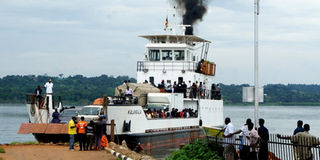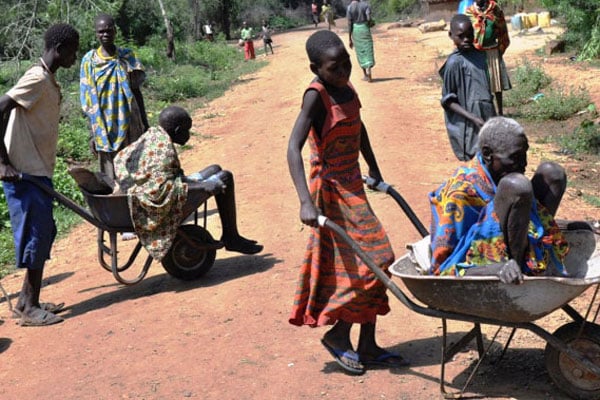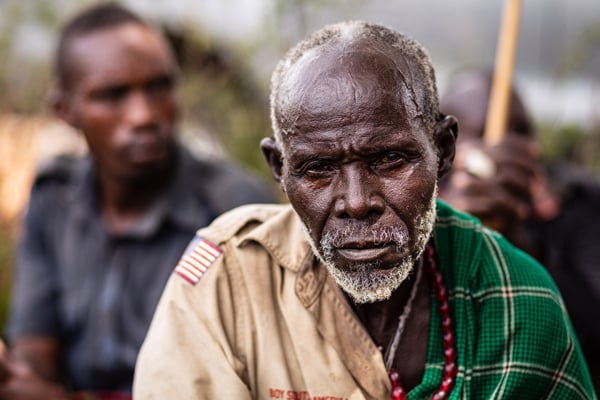Prime
Kalangala’s costly refurbishment

MV Kalangala docks at Nakiwogo Landing Site in Entebbe on February 7, before it was taken for servicing. PHOTO | EVE MUGANGA
What you need to know:
- A multi-million-dollar project to power the engines of growth at Kalangala Island, a lush backwater floating on Lake Victoria was conceived by the Finance ministry in the late 1990s. It kicked off in 2005 but concerns have been raised about its staggering costs, including a recent report by the Auditor General that detailed, among others, questionable payments and recommended that government re-examines clauses in the Public Private Partnership (PPP) deal.
Kalangala District, a necklace of 64 habitable islands interspersed with lush vegetation, is a jewel in the crown for those seeking a holiday.
To the north, the island is bordered by Masaka District from which it was carved in 1989, Mpigi and Wakiso, Masaka, Kalungu and Rakai to the west, Mukono to the east, and farthest to the south is Tanzania.
Tucked away in the dark-blue expanse of Lake Victoria, it is only until about seven years, that the island became more accessible, thanks in part to improvement in telecommunications, the rush for land to build tourism facilities, and largely palm oil growing.
Today, the main Bugala Island is a beehive of activity. The island is situated on Lake Victoria in Uganda’s Kalangala District and has undergone a transformation over the past decade.
Likewise, accessibility to any of the islands from Bugala is easier. And generally, livelihoods of the islanders are much better today than, for example, 10 years ago when Kalangala, according to a United Nations Development Programme (UNDP) Human Development Index was ranked among the poorest districts in the country.
According to the 2014 national census, Kalangala had one of the smallest populations of 53,406 persons against the national head count of about 45 million.
In 1997, government and the UN’s International Fund for Agricultural Development conceptualised large-scale palm tree growing in Kalangala as part of the Vegetable Oil Development project to address rural poverty by involving smallholder farmers in vegetable oil crops production.
The palm tree project was fast-tracked in the late 1990s and early 2000s, and subsequently in 2003 when government signed an agreement with Oil Palm Uganda Limited, which eventually kick-started the project.

A palm plantation in Kalangala District. In 2003 government signed an agreement with Oil Palm Uganda Limited. PHOTO | FILE
Then serving as director of economic affairs in the ministry, Mr Keith Muhakanizi, who is now the ministry’s Permanent Secretary to the Treasury, recalls travelling to Kalangala, a journey he described as “hell.”
“Around 1999/2000 we went to Kalangala; household survey had just come out showing the seven poorest districts, so we sampled out Bushenyi, Kalangala and Kampala, and others to compare the urban poor of these districts,” Mr Muhakanizi told Daily Monitor in an interview last Friday.
“One of, if not the poorest, was Kalangala. At that time the ferry was offering only one or two trips a week to the island, and the place was really another world,” he added.
The rebirth
Mr Muhakanizi said after signing off the project in 2004, government committed itself to providing infrastructure, ferry services, a road on the main Bugala Island, clean water access, and electricity.
“We were stuck because we did not have money, but a company called InfraCo came on board; it was owned by donors, it agreed to providing us a loan, and a grant. The grant of $5m was very useful because it would help us work on the water and electricity services,” he said, adding: “To the best of my knowledge, we did one of the best projects on solar, the water is there, the ferry is there, what else?”
“We opted for this kind of blended financing arrangement; loan/grant, and a guarantee from USAID to lower the interest rate of the loan. Such an arrangement doesn’t come every day,” Mr Muhakanizi said.
The arrangement led government in 2005 to enter a Public-Private Partnership (PPP) arrangement with infraco to form a special purpose vehicle called Kalangala Infrastructure Services (KIS) to undertake the services to complement the palm-growing project, and to uplift lives of the islanders.
Today, government through Uganda Development Corporation has a 46 per cent stake in KIS.
Other equity shareholders are Infraco Africa Ltd, with debt and equity financing from Nedbank from South Africa, Emerging Africa Infrastructure Fund, and Private Infrastructure Development Group. KIS effectively commenced operations in 2011.
The total project investment is estimated at $49.56m (about Shs181b) for which government was required to pay in advance the annual and quarterly support payments to KIS for upgrading the road and ferry services, first through the Uganda National Roads Authority (UNRA) between 2012 and 2017, and through ministry Works starting in 2018.
Officials claim KIS was designed as a PPP to achieve the economies of scale necessary to attain project finance, operate efficiently and serve the island residents with improved access to clean water, safer transportation and more reliable solar-powered electricity.
But over the years, concerns have been raised about the efficacy of the project.
In his recent audit submitted to Parliament early this year, Auditor General John Muwanga said the idea of KIS was merely based on InfraCo’s research market analysis and development plan, and government did not undertake its own needs assessment to evaluate the best possible service delivery options as a basis for the investment decision.
“KIS was directly sourced by Ministry of Finance without consideration of alternative providers to compare the costs and benefits and establish the best option as required by the procurement regulations,” Mr Muwanga said, further detailing that as a result, the ministry cannot ascertain whether infrastructure investment option chosen for Kalangala is the most economical, efficient and effective for both government and the islanders.
For example, part of the undertakings for KIS was to upgrade the main road on Bugala, 66km Luuku–Kalangala–Mulabana, which was completed in March 2016 for which government paid Shs40.16 billion in form of road support.
However, government committed to paying an additional Shs120b as road support for more than a 13-year period from 2016, which the audit considered too costly considering that KIS is not responsible for road maintenance.
Today, the same road is in bad shape and is already disintegrating; the worst part is a 30-kilometre stretch between Bugoma and Bweya villages.
The KIS managing director, Mr John Opondo, told Daily Monitor that upon upgrading the road according to the terms of the agreement, it became a responsibility of the central government.
“It is true the road is in fairly bad state but then it is an issue of maintenance. Once there is a failure on that part you cannot expect it to remain intact; roads break,” Mr Opondo said.
UNRA, which is in charge of the national roads network told this newspaper it does not have any business with KIS.
Essential services at a cost
Regardless of whatever is said, Mr Opondo said Kalangala is much better off today.
“Yes, I can judge myself that we have made a big difference since we started,” he said.
“Government through UDC has a stake in this project, so as for any investment with public money it should be put under a microscope.”
He said the Shs40b that government paid for the road included a component of acquiring the right of way as a requirement so there was no money lost at all and the project has “value for money for taxpayers.”
“It is also important to note that the money for the road includes the ferry landings both at Bukakata and Luuku islands, which have been effectively operational since they were launched.
“Even with the recent rise in water levels that made water transport impossible across the lake, it is only those two have been operational,” he said.
Audit
According to the audit, the two ferries under KIS operating at Bukakata and Luuku islands with a capacity of 206 passengers are fully operational.
However, KIS has not paid government the annual licence and ferry operating fees amounting to $275,000 (Shs1b) and the agreement does not provide for penalties for delayed payment of annual ferry operating fees.
In addition, it was established that following the amendment of the Implementation Agreement, ferry service support payments were adjusted from the ferry traffic (passengers and vehicles) based payments to per trip payment terms,” the audit notes.
“KIS indicated that it was less cumbersome to monitor the number of trips compared to monitoring passengers and vehicles. However, on further analysis of relevant documentation, it was revealed that a passenger manifest is prepared for each trip which could have been used to compute the traffic-based payment.”
But according to the audit, evaluation of both options reveals that the trip option is costly and resulted in government paying Shs16b more in the first six years of the ferry operations.
Also, in the event of KIS failing to provide a ferry service as a result of government’s default in payments, KIS would be deemed to have operated a ferry service; as a result of this government had paid a total of Shs871m in respect of deemed trips arising from 308 non-performed trips in 2017.
As regards, water services that KIS is supposed to provide, the audit noted that it is only accessible to 16 per cent of the residents in Bugala.
Electricity was also a sticky issue raised in the audit query. KIS constructed a solar plant with capacity of 1.6 megawatts (per hour) with transmission and distribution lines serving the major settlements on Bugala but a scrutiny into KIS’s performance reports revealed that the company had attained the customer connection target set at 3,000 customers in 2018 as set out in the power licence agreement.
However, KIS faces a challenge of low utilisation as the maximum load attained during the period under review was 0.4 megawatts per hour putting average utilisation capacity below 25 per cent of installed capacity.
The audit reveals that when it comes to oversight no government agency has been appointed yet, whereas KIS had designated consulting agency Mott McDonalds as its independent monitor. The implementation agreement establishing KIS in 2009 pointed to establishment of an oversight committee.
As a result of the abdication of this oversight role, the audit detailed that government had made erroneous payments to KIS amounting to Shs13b as a result of application of wrong base factors and Shs564m due to application of wrong consumer price indices.
In addition, government did not recover Shs686m resulting from a decrease in the cost of operating ferry services.
To ensure proper implementation of the project, Mr Muwanga recommended that government through the Finance ministry “invokes the re-negotiation clause such that KIS services are offered at reasonable costs.”
In summary, Kalangala is much better and accessible today than it was say a decade ago, thanks in part to the services offered through the ongoing PPP deal. But going by the Auditor General’s report, the plan to give the remote island a ‘fresh coat of paint’ and turn it into an accessible tourism gem may cost the taxpayer much more than it was anticipated.
Balancing costs and service
At Bugala, locals and leaders are pleased with the project regardless of the costs they are oblivious about.
The Bujumba County MP in which Bugala lies, Mr Julius Opondo, told Daily Monitor that Kalangala is much better today. It a view shared by the locals. Perhaps some costly mistakes could have been avoided.
Mr Muhakanizi said initially they planned the infrastructure the road and ferry to be paid for but Cabinet overruled them and directed that any cost involved be borne by government.
“Are the auditors saying the services paid for are not being given? To the best of my knowledge the contract was properly done,” he said. “When they say we did not do a cost benefit analysis; sometimes these accountants and auditors should not do the work of the experts for we followed guidance by Cabinet; the ferry are offering the trips, now four and supposed to be increased to eight daily”.
He argued that infrastructure is an expensive venture.
Asked why the ministry opted for KIS/InfraCo as the best service provider, the director of economic affairs, Mr Keith Muhakanizi, said the decision to zero down on them was based on blended financing structure of a loan, grant and guarantee they brought on board; the alternative was to borrow, which in his view would be costly.
Both Mr Muhakanizi and Opondo rebutted claims of underhand dealings in the award of the contract.




